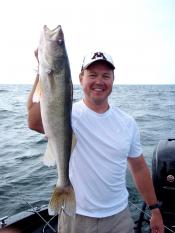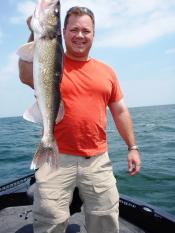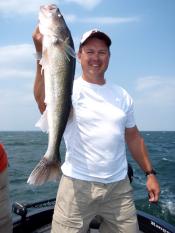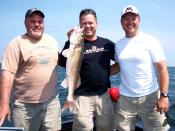 As the warm weather heats up, so does the open water trolling bite on Mille Lacs. For the first time in a long time, I jumped in someone else’s boat to fish the open basin via crankbaits and planer boards. Kevin Hines (KevinH) just bought a beautiful 2011- 621 Ranger powered by a 300 Verado and it was time to put some slime in his boat! It was great to sit back and let Kevin run the show and me feeling no pressure at all!
As the warm weather heats up, so does the open water trolling bite on Mille Lacs. For the first time in a long time, I jumped in someone else’s boat to fish the open basin via crankbaits and planer boards. Kevin Hines (KevinH) just bought a beautiful 2011- 621 Ranger powered by a 300 Verado and it was time to put some slime in his boat! It was great to sit back and let Kevin run the show and me feeling no pressure at all!
Joining us was Kevin’s friends John Benson and his brother Dave Benson. Both of these guys caught on very quickly to the open water trolling system and it was easy to see that they have spent some time on the water. We motored out to the mud flat areas and where we had some success the last time out. We quickly got our lines out and about 5 minutes into our first troll run, a planer board took off screaming and shortly after Dave boated his first Mille Lacs suspended walleye – a nice 26.5 inch fish! A great start to our day! That fish was the first of many and it was pretty consistent from then on. We ended up catching 21 walleyes in 5 hours of fishing. Not bad considering we only fished for 5 hours and our day was cut short at 2:30pm due to some approaching thunderstorms. We also had 3 doubles (Kevin calls it the Chinese fire drill) and kept one 16 ¾ inch fish for the frying pan. Hot crankbait of the day was a Rapala Deep Tail Dancer DDT#11 – purple clown flash trolled down about 27 feet. We caught more fish today on braid with planer boards and we had one rod that was on fire picking up the majority of our fish.
One of the keys to our success was Kevin being able to control his boat and our speed. It was windy out there (15-25 MPH winds) and we encountered some pretty big rollers throughout the day. When trolling in rough conditions, it’s key to keep the bow of your boat pointing in the same direction of the wind. This will help prevent boat surges and keep your lines/crankbaits swimming more consistenly. It’s also extremely important to watch your speed and you must continuously make adjustments. Kevin did a great job keeping our speed to as close as possible to 2.0 MPH. Having a trollmaster to help control the speed of the kicker motor also gave us a big advantage.
 I was recently asked if I use mono or braid leaders on my leadcore setups. It depends on the fishing situation. If you are typically fishing structure or dirty stained water that has a lot of debris in it, braid is probably the best way to go. Since there’s no stretch, you’ll be able to read the vibrations on your rod tip a little easier and know when you’re nicking the bottom or if you get any debris on your line. If you’re fishing clear water such as Mille Lacs and your targeting suspended walleyes, monofilament or fluorocarbon line may be a better choice which can help reduce the risk of spooking fish. The stretch in the line can also help when playing a bigger fish and absorb some of those head shakes. It’s simply more forgiving versus using braid. When I’m open water trolling on Mille Lacs, I usually fish with 50 foot mono leaders (10 lb. Berkeley XT).
I was recently asked if I use mono or braid leaders on my leadcore setups. It depends on the fishing situation. If you are typically fishing structure or dirty stained water that has a lot of debris in it, braid is probably the best way to go. Since there’s no stretch, you’ll be able to read the vibrations on your rod tip a little easier and know when you’re nicking the bottom or if you get any debris on your line. If you’re fishing clear water such as Mille Lacs and your targeting suspended walleyes, monofilament or fluorocarbon line may be a better choice which can help reduce the risk of spooking fish. The stretch in the line can also help when playing a bigger fish and absorb some of those head shakes. It’s simply more forgiving versus using braid. When I’m open water trolling on Mille Lacs, I usually fish with 50 foot mono leaders (10 lb. Berkeley XT).
I received an email last week and someone asked me “Why do you use leadcore line, when your deep diving crankbaits (Rapala Deep Tail Dancers DDT11 and Storm Deep Thunderstics) can achieve the same depths with mono or braid?”
 One of biggest advantages when using leadcore line is that corners better than other lines and it reacts slower in regard to changes of direction and speed. This will apply when you are fishing in windy conditions and your boat is being thrashed around in the waves. There’s a bow in your line when using leadcore and as you encounter a wave, the bow will either increase or decrease and the result of that it will have minimal effect of the crankbait’s swimming action. When using braided line (that has no stretch and does not have a bow), your crankbait will react a lot quicker and sometimes the waves will even cause a pull/pause effect. Every day is a little different out there and sometimes this pull/pause effect will trigger strikes like it did for us today and other times the walleyes want nothing to do with it. Another leadcore application would be when you are trolling contours and/or structure. Your crankbait will follow your boat path much better when trolling with leadcore versus mono or braid that will cut the corners. Your crankbait will be in the strike zone more consistently and it won’t plane out at higher speeds.
One of biggest advantages when using leadcore line is that corners better than other lines and it reacts slower in regard to changes of direction and speed. This will apply when you are fishing in windy conditions and your boat is being thrashed around in the waves. There’s a bow in your line when using leadcore and as you encounter a wave, the bow will either increase or decrease and the result of that it will have minimal effect of the crankbait’s swimming action. When using braided line (that has no stretch and does not have a bow), your crankbait will react a lot quicker and sometimes the waves will even cause a pull/pause effect. Every day is a little different out there and sometimes this pull/pause effect will trigger strikes like it did for us today and other times the walleyes want nothing to do with it. Another leadcore application would be when you are trolling contours and/or structure. Your crankbait will follow your boat path much better when trolling with leadcore versus mono or braid that will cut the corners. Your crankbait will be in the strike zone more consistently and it won’t plane out at higher speeds.
Second reason I use leadcore line is depth control – you can control the depth of your crankbaits by adjusting your trolling speed versus reeling in line or letting more line out. For example, let’s say you’re targeting suspended walleyes and your graphing some arcs on your sonar that vary in depth of 5-10 feet. When trolling leadcore line, all you need to do is speed up a little bit and those cranks will move up higher in the water column where you’re marking those arcs and then back to your normal speed when you want your cranks to go back down. This can also apply when fishing structure. You simply speed up a bit to raise your cranks up higher and keep them from bottoming out on the structure below and then go back to your normal speed when you want to achieve your normal depths. The faster you troll with leadcore – the higher your crankbait will run and vice versa.
 Another reason why I use leadcore is because it can change the angle of your deep diving crankbait. On certain days when the conditions are manageable, sometimes all my hits are all on leadcore lines even though my long lining braded lines have the exact some crankbait/color and are running at the same depths. I believe one of the reasons why is the leadcore line can affect the angle of the crankbait and the swimming action. When trolling those deep diving crankbaits with braid, your line is completely straight from the split ring of your crankbait all the way up to your rod tip or your planer board thus creating a sharper degree of angle. When trolling with leadcore, there’s a distinct bow in your line and I feel this affects the angle of the crankbait. The angle is not as sharp and because of this, I feel it gives the walleyes a little bit different look. This may be the ticket one day and then the very next day they prefer the sharper angle with the braided line. The key is to recognize the difference and give them what they want versus forcing one presentation over another.
Another reason why I use leadcore is because it can change the angle of your deep diving crankbait. On certain days when the conditions are manageable, sometimes all my hits are all on leadcore lines even though my long lining braded lines have the exact some crankbait/color and are running at the same depths. I believe one of the reasons why is the leadcore line can affect the angle of the crankbait and the swimming action. When trolling those deep diving crankbaits with braid, your line is completely straight from the split ring of your crankbait all the way up to your rod tip or your planer board thus creating a sharper degree of angle. When trolling with leadcore, there’s a distinct bow in your line and I feel this affects the angle of the crankbait. The angle is not as sharp and because of this, I feel it gives the walleyes a little bit different look. This may be the ticket one day and then the very next day they prefer the sharper angle with the braided line. The key is to recognize the difference and give them what they want versus forcing one presentation over another.
The last reason I like leadcore is when I’m fishing in windy conditions like today. As you encounter the bigger waves out there, your boat will surge forward. The bow in your leadcore line will absorb some of this surge and keep your crankbait swimming properly versus having that pull/pause effect. Even though this seems like a very minor thing, it can make a huge difference out there and having an OK day turn out to be a great day. Again, they may want this one day and not the next. It’s up to you to recognize it and realize that all the little things make a difference out there.
Now’s the time to get out there and try open water trolling. My last report “Open Water Trolling, Mille Lacs Lake-June 2, 2012” covered how to scout for these fish and hopefully this one gave you some tips about the advantages of using leadcore line and how to toll in rough conditions. Put those two together and you now have a couple of pieces to the puzzle.
As always, I’m here to help so keep the emails and PM’s coming. For those of you who want to learn the open water trolling system – I’m putting on some Open Water / On the Water Trolling Clinics where I’ll show you the keys to success as we catch fish. Just send me a PM or Email and I’ll add you to the list!
Until next time – keep trollin’
A few more pics…
Last one is the Chinese Fire Drill (a double).
Great Report Brad! Nice Work
Thanks Brad!
More great info!! thanks Brad!!

Great report as always Brad. Not only was the fishing great yesterday but riding the waves was fun as well
Nice job and great report as alway’s! See ya out there this weekend
See ya out there this weekend 
